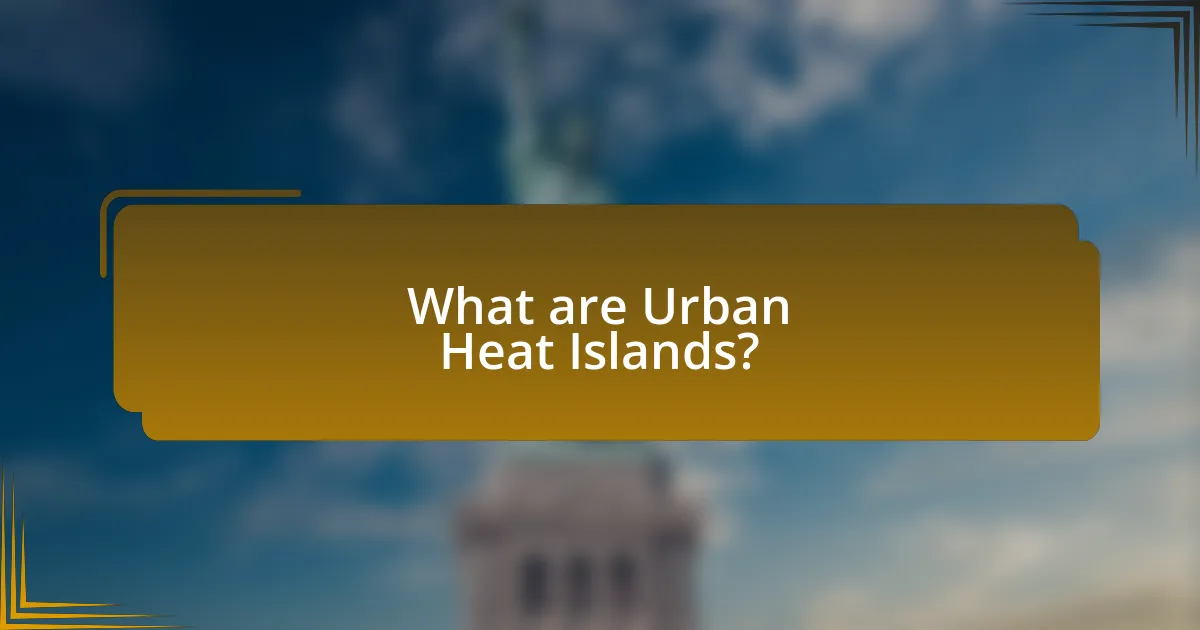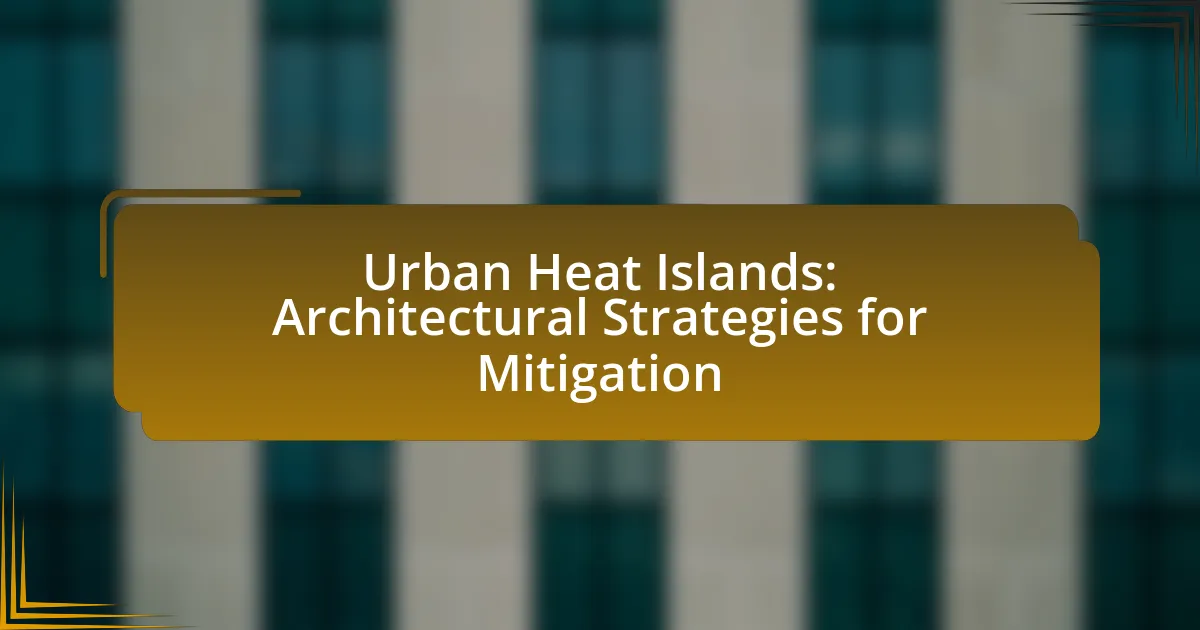Urban Heat Islands (UHIs) are urban areas that experience significantly higher temperatures than their rural surroundings due to human activities and infrastructure. This article explores the formation of UHIs, the contributing factors such as land use and vegetation, and their effects on urban environments, including increased energy consumption and health risks. It also discusses architectural strategies for mitigation, including the use of green roofs, reflective materials, and urban planning practices that enhance vegetation. Successful case studies from cities like Chicago and New York illustrate effective implementations of these strategies, highlighting the importance of community involvement and sustainable design in reducing UHI effects.

What are Urban Heat Islands?
Urban Heat Islands are urban areas that experience significantly higher temperatures than their rural surroundings due to human activities and modifications to land surfaces. This phenomenon occurs primarily because of the concentration of buildings, roads, and other infrastructure that absorb and retain heat, along with reduced vegetation and water bodies that typically help cool the environment. Studies indicate that urban areas can be up to 5 to 7 degrees Fahrenheit warmer than nearby rural areas, particularly during summer months, which can exacerbate energy consumption, air pollution, and heat-related health issues.
How do Urban Heat Islands form?
Urban Heat Islands form primarily due to the concentration of human activities and infrastructure in urban areas, which absorb and retain heat. The materials commonly used in cities, such as asphalt and concrete, have high thermal mass, leading to increased temperatures compared to surrounding rural areas. Additionally, reduced vegetation and tree cover in urban settings limit natural cooling through shade and evapotranspiration. Studies indicate that urban areas can be 2 to 5 degrees Fahrenheit warmer than their rural counterparts, particularly during the night, due to these factors.
What factors contribute to the development of Urban Heat Islands?
Urban Heat Islands develop primarily due to the concentration of human activities and infrastructure in urban areas. Factors contributing to this phenomenon include the extensive use of concrete and asphalt, which absorb and retain heat, reducing natural cooling processes. Additionally, the lack of vegetation in cities limits shade and evapotranspiration, further exacerbating temperature increases. Urban design elements, such as building height and density, can trap heat, while waste heat from vehicles, industrial processes, and air conditioning systems adds to the overall warmth. Studies have shown that urban areas can be significantly warmer than surrounding rural areas, with temperature differences reaching up to 5 degrees Celsius or more, particularly during summer months.
How do land use and vegetation impact Urban Heat Islands?
Land use and vegetation significantly impact Urban Heat Islands (UHIs) by influencing surface temperatures and heat absorption. Urban areas with extensive impervious surfaces, such as asphalt and concrete, absorb and retain heat, leading to elevated temperatures compared to surrounding rural areas. Conversely, vegetation, particularly trees and green spaces, provides shade and facilitates evapotranspiration, which cools the air and mitigates heat accumulation. Studies have shown that areas with higher tree canopy cover can experience temperature reductions of up to 5 degrees Celsius compared to areas with minimal vegetation. This relationship underscores the importance of integrating green infrastructure and sustainable land use practices to effectively reduce UHI effects.
What are the effects of Urban Heat Islands on urban environments?
Urban Heat Islands (UHIs) significantly increase temperatures in urban environments compared to surrounding rural areas. This temperature rise leads to higher energy consumption for cooling, exacerbating air pollution and increasing greenhouse gas emissions. Studies indicate that urban areas can be 2 to 5 degrees Fahrenheit warmer than their rural counterparts, which can elevate heat-related health risks, particularly for vulnerable populations. Additionally, UHIs can negatively impact water quality by raising the temperature of stormwater runoff, which can harm aquatic ecosystems.
How do Urban Heat Islands influence local climate and weather patterns?
Urban Heat Islands (UHIs) significantly raise local temperatures compared to surrounding rural areas, primarily due to human activities and urban infrastructure. This temperature increase alters local climate and weather patterns by intensifying heatwaves, increasing energy demand for cooling, and affecting precipitation patterns. For instance, studies have shown that urban areas can be 2 to 5 degrees Fahrenheit warmer than their rural counterparts, leading to localized weather phenomena such as increased humidity and altered wind patterns. Additionally, the UHI effect can enhance the formation of thunderstorms and influence the distribution of rainfall, as warmer air holds more moisture, potentially leading to heavier precipitation events in urban areas.
What health risks are associated with Urban Heat Islands?
Urban Heat Islands (UHIs) pose significant health risks, primarily through increased heat-related illnesses and mortality. Elevated temperatures in urban areas can exacerbate conditions such as heat exhaustion and heat stroke, particularly among vulnerable populations like the elderly and those with pre-existing health conditions. Research indicates that during heat waves, cities can experience temperature increases of 2 to 5 degrees Fahrenheit compared to surrounding rural areas, leading to a higher incidence of hospitalizations for heat-related illnesses. Additionally, UHIs can worsen air quality by increasing ground-level ozone, which is linked to respiratory issues, cardiovascular diseases, and overall increased morbidity. Studies have shown that urban populations are at a greater risk of these health impacts, highlighting the urgent need for mitigation strategies to address the effects of UHIs.

What architectural strategies can mitigate Urban Heat Islands?
Architectural strategies that can mitigate Urban Heat Islands include the use of green roofs, reflective materials, and urban vegetation. Green roofs, which involve planting vegetation on building rooftops, can reduce surface temperatures by providing insulation and increasing evapotranspiration. Studies show that green roofs can lower rooftop temperatures by up to 40% compared to conventional roofs. Reflective materials, such as cool roofing and light-colored pavements, can also significantly decrease heat absorption, with some materials reflecting up to 90% of sunlight. Additionally, increasing urban vegetation through tree planting and green spaces can enhance shade and cooling, contributing to lower ambient temperatures. Research indicates that urban areas with more trees can experience temperature reductions of 2 to 5 degrees Celsius. These strategies collectively contribute to reducing the intensity of Urban Heat Islands and improving urban climate resilience.
How can building materials reduce heat absorption?
Building materials can reduce heat absorption by utilizing reflective surfaces, insulating properties, and thermal mass. Reflective surfaces, such as cool roofs, are designed to reflect more sunlight and absorb less heat, which can lower surface temperatures significantly. For instance, studies show that cool roofs can reduce roof temperatures by up to 30% compared to traditional dark roofs. Insulating materials, like expanded polystyrene or mineral wool, minimize heat transfer, keeping interiors cooler during hot weather. Additionally, materials with high thermal mass, such as concrete or brick, can absorb heat during the day and release it at night, helping to moderate temperature fluctuations. These strategies collectively contribute to mitigating the urban heat island effect, enhancing energy efficiency and comfort in urban environments.
What types of reflective materials are effective in urban design?
Effective reflective materials in urban design include cool roofing materials, reflective pavements, and high-albedo surfaces. Cool roofing materials, such as white or light-colored roofing membranes, can reflect sunlight and reduce heat absorption, leading to lower building temperatures and energy savings. Reflective pavements, often made from light-colored concrete or specialized coatings, help mitigate heat by reflecting solar radiation, thus cooling the surrounding environment. High-albedo surfaces, which have a high solar reflectance index, are utilized in various urban applications, including walls and sidewalks, to minimize heat retention. Studies have shown that implementing these materials can significantly reduce urban heat island effects, contributing to more sustainable urban environments.
How does green roofing contribute to temperature regulation?
Green roofing contributes to temperature regulation by providing insulation and reducing heat absorption in urban environments. The vegetation and soil layers of green roofs absorb sunlight, which decreases the amount of heat that is transferred to the building and the surrounding air. Studies have shown that green roofs can lower surface temperatures by up to 40% compared to conventional roofs, thereby mitigating the urban heat island effect. Additionally, the evapotranspiration process from the plants on green roofs cools the air, further contributing to lower ambient temperatures in urban areas.
What role does urban planning play in mitigating Urban Heat Islands?
Urban planning plays a crucial role in mitigating Urban Heat Islands (UHIs) by implementing strategies that reduce heat absorption and enhance cooling. Effective urban planning incorporates green spaces, such as parks and green roofs, which can lower surface temperatures by providing shade and increasing evapotranspiration. Research indicates that urban areas with increased vegetation can experience temperature reductions of up to 5 degrees Celsius compared to those with minimal greenery. Additionally, urban planning promotes the use of reflective materials in building designs and roadways, which can decrease heat retention. Studies show that reflective surfaces can reduce surface temperatures by 10-20 degrees Fahrenheit. By integrating these strategies, urban planning significantly contributes to the reduction of UHI effects, improving overall urban climate resilience.
How can the integration of green spaces help lower urban temperatures?
The integration of green spaces can significantly lower urban temperatures by enhancing evapotranspiration and providing shade. Green spaces, such as parks and green roofs, absorb sunlight and release moisture into the air, which cools the surrounding environment. Research indicates that urban areas with increased vegetation can experience temperature reductions of up to 5 degrees Celsius compared to areas with minimal greenery. Additionally, a study published in the journal “Environmental Science & Technology” by Bowler et al. (2010) found that urban green spaces can mitigate the urban heat island effect, leading to improved thermal comfort and reduced energy consumption for cooling.
What zoning regulations can support heat mitigation strategies?
Zoning regulations that can support heat mitigation strategies include requirements for green roofs, increased tree canopy coverage, and the use of reflective materials in building design. These regulations promote urban vegetation, which can lower surface and air temperatures, thereby reducing the urban heat island effect. For instance, cities like San Francisco have implemented zoning codes that mandate a certain percentage of green space in new developments, which has been shown to effectively decrease local temperatures. Additionally, regulations that encourage the use of cool pavements and limit the amount of impervious surfaces can further enhance heat mitigation efforts by allowing for better water absorption and evaporation, contributing to cooler urban environments.

What are the best practices for implementing mitigation strategies?
The best practices for implementing mitigation strategies against Urban Heat Islands include utilizing reflective materials, increasing vegetation, and optimizing building designs. Reflective materials, such as cool roofs and pavements, can significantly reduce surface temperatures by reflecting more sunlight, as evidenced by studies showing temperature reductions of up to 20°F in urban areas. Increasing vegetation through urban greening initiatives, like parks and green roofs, enhances shade and evapotranspiration, which can lower surrounding temperatures. Additionally, optimizing building designs by incorporating energy-efficient systems and natural ventilation can further mitigate heat accumulation. These strategies collectively contribute to a more sustainable urban environment and have been supported by research indicating their effectiveness in reducing urban heat impacts.
How can cities effectively implement these architectural strategies?
Cities can effectively implement architectural strategies to mitigate urban heat islands by integrating green roofs, reflective materials, and urban vegetation into building designs. These strategies reduce heat absorption and promote cooling through natural processes. For instance, studies show that green roofs can lower surface temperatures by up to 40% compared to conventional roofs, significantly decreasing the urban heat effect. Additionally, using reflective materials can reduce heat gain by 20-30%, as demonstrated in various urban projects. Implementing these strategies requires collaboration between city planners, architects, and local governments to establish guidelines and incentives that encourage sustainable building practices.
What are the challenges cities face in adopting heat mitigation measures?
Cities face significant challenges in adopting heat mitigation measures, primarily due to financial constraints, lack of political will, and insufficient public awareness. Financial constraints hinder the implementation of necessary infrastructure changes, as cities often operate under tight budgets and prioritize immediate needs over long-term investments. Lack of political will can result in inadequate policy support and slow decision-making processes, which delay the adoption of effective heat mitigation strategies. Additionally, insufficient public awareness about the benefits of heat mitigation can lead to resistance against proposed measures, making it difficult for city officials to garner community support. These challenges collectively impede the effective implementation of strategies aimed at reducing urban heat islands and improving overall urban resilience.
How can community involvement enhance the effectiveness of these strategies?
Community involvement can enhance the effectiveness of strategies to mitigate Urban Heat Islands by fostering local engagement and ensuring that solutions are tailored to specific community needs. When residents participate in the planning and implementation of green infrastructure, such as urban parks and tree planting initiatives, they contribute valuable insights about their environment and preferences. Research indicates that community-led projects often result in higher levels of maintenance and sustainability, as local stakeholders are more likely to take ownership of these initiatives. For example, a study by the American Planning Association found that neighborhoods with active community participation in urban greening efforts experienced a 20% increase in tree canopy cover compared to those without such involvement. This demonstrates that community engagement not only improves the relevance of mitigation strategies but also enhances their long-term success and effectiveness.
What are some successful case studies of Urban Heat Island mitigation?
Successful case studies of Urban Heat Island (UHI) mitigation include the implementation of green roofs in Chicago, which has led to a temperature reduction of up to 5°F in urban areas. The Chicago Green Roof Initiative, launched in 2001, has resulted in over 5 million square feet of green roofs, significantly decreasing surface temperatures and improving air quality. Another example is the Cool Roofs program in New York City, which has coated over 6 million square feet of rooftops with reflective materials, reducing heat absorption and lowering surrounding temperatures by approximately 3°F. Additionally, the city of Los Angeles has adopted a comprehensive urban forestry program, planting over 1 million trees, which has been shown to lower local temperatures by 2-4°F and enhance urban biodiversity. These case studies demonstrate effective strategies for mitigating UHI effects through urban planning and architectural interventions.
Which cities have effectively reduced Urban Heat Islands through architecture?
Cities that have effectively reduced Urban Heat Islands through architecture include Los Angeles, Singapore, and Tokyo. Los Angeles implemented green roofs and reflective pavements, resulting in a 10% reduction in surface temperatures. Singapore’s extensive use of vertical gardens and green buildings has led to a significant decrease in urban temperatures, with studies showing a cooling effect of up to 4 degrees Celsius in certain areas. Tokyo has adopted urban forestry and cool roofs, contributing to a 3-degree Celsius reduction in heat during peak summer months. These architectural strategies demonstrate successful mitigation of Urban Heat Islands in these cities.
What lessons can be learned from these successful implementations?
Successful implementations of architectural strategies for mitigating Urban Heat Islands demonstrate the importance of integrating green infrastructure, such as green roofs and urban vegetation, into urban planning. These strategies have been shown to reduce surface and air temperatures significantly, with studies indicating that green roofs can lower temperatures by up to 40% compared to conventional roofs. Additionally, the use of reflective materials in building designs has proven effective, as reflective surfaces can decrease heat absorption, leading to cooler urban environments. The evidence from cities that have adopted these strategies highlights the necessity of collaboration among urban planners, architects, and policymakers to create sustainable and resilient urban spaces.
What practical tips can be applied to reduce Urban Heat Islands in local communities?
To reduce Urban Heat Islands in local communities, implementing green roofs is an effective strategy. Green roofs can lower surface temperatures by providing insulation and increasing vegetation cover, which has been shown to reduce ambient temperatures by up to 5 degrees Fahrenheit in urban areas. Additionally, increasing tree canopy coverage through urban forestry initiatives can significantly mitigate heat, as trees provide shade and release moisture through transpiration, effectively cooling the surrounding air. Studies indicate that areas with 30% tree cover can experience temperature reductions of 2 to 4 degrees Fahrenheit compared to areas with minimal tree cover. Furthermore, using reflective or light-colored materials for pavements and rooftops can decrease heat absorption, with reflective surfaces reducing surface temperatures by as much as 20 degrees Fahrenheit. These strategies collectively contribute to lowering urban temperatures and improving community resilience against heat.
